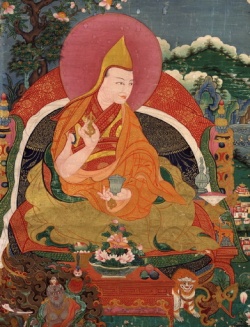Bsod nams rgya mtsho, The Third Dalai Lama (1543–88)
Bsod nams rgya mtsho, The Third Dalai Lama (1543–88)
Bsod nams rgya mtsho was the leading hierarch of the Dge lugs pa school of Tibetan Buddhism during a time when competition from rival sects within Central Tibet, especially the bKa’ rgyud pa, drove them to seek political and religious patronage from sponsors outside the Tibetan cultural regions. Such a practice of Tibetan Buddhist leaders seeking support from non-Tibetan patrons stretched back to the Yuan and had become established by the end of the Ming. This was due to the decentralized power of the Mongols that allowed different Tibetan Buddhist leaders to gain support from different branches of the Mongol imperial family. While the Tibetans did not have a centralized missionary aim, their own quest for patronage took place within the broader context of struggles between Mongol, Manchu, and Chinese groups over political and territorial primacy in Inner Asia.
Within such a context, the Mongols revived the lama-patron relationship in the late sixteenth century in an attempt to expand their political authority using Tibetan Buddhism. Altan Khan (1521–82), ruler of the Tumed Mongols, then the most powerful group in Inner Asia, met with Bsod nams rgya mtsho in the region of Kokonor (Tib. Mtsho kha/Mtsho sngon, Ch. Qinghai) in 1578. During this meeting, Altan Khan accepted Bsod nams rgya mtsho as his “spiritual guide and refuge” and gave him the title of “Dalai Lama.” In return, Bsod nams rgya mtsho gave Altan Khan the title of “Protector of the Faith.” Altan Khan’s conversion to the dGe lugs pas can be seen as part of a broader attempt to subvert his nominal superior, Tumen Khan (1558–92) of the Chakhar Mongols, who had cultivated relationships with the Sa skya pa, and who were allied with the declining Ming against the new Manchu state. Meanwhile, Bsod nams rgya mtsho gained for the Dge lugs pa the support of a powerful and wealthy patron, which enabled him to consolidate Dge lugs pa strongholds in Tibetan and Mongol regions as well gain the attention of the Ming court in Beijing.
The year after this meeting, Bsod nams rgya mtsho sent Stong ‘khor chos rje Yon tan rgya mtsho, the first Chahan lama, to Altan Khan as his representative to the Mongols. In 1583, Bsod nams rgya mtsho embarked on a second mission from Central Tibet, which took him first to the birthplace of Tsong kha pa (1357–1419), the founder of the Dge lugs pa school, in A mdo. Here, he founded an innovative Dge lugs pa school at Sku ‘bum that later produced many Dge lugs pa missionaries to northeast Asia for the next two centuries. He also visited monasteries linked to Tsong kha pa’s disciple, Shakya Ye shes, and ensured their legacies as Dge lugs pa institutions. In 1585, Bsod nams rgya mtsho went to Koke khota (Tib. Mkhar sngon, Ch. Guihuacheng), the capital of Tumed Mongol territory, at the request of Altan Khan’s son. Here he established a translation school near the Chinese border. The next year, Bsod nams rgya mtsho visited the territory of the Kharchin Mongols, where he established another translation school. In 1588, he traveled further northeast at the invitation of the Khorchin. There he gave the Khorchin khan a Hevajra empowerment and consecrated the establishment of a monastic community. Owing to his reputation and activities among the Mongols, Bsod nams rgya mtsho was invited to the Ming court in 1588 by the Wanli emperor (r.1572–1620), who gave him the title of the Great Imperial Preceptor who Confers Initiations (Guanding tai guoshi). Bsod nams rgya mtsho was intending to accept this invitation when he fell ill and died in Mongol regions in 1588.
Before his death in 1588, bSod nams rgya mtsho predicted he would be reincarnated in Mongolia (indeed, the fourth Dalai Lama was recognized in the nephew of Altan Khan), thus beginning the line of Dalai Lama reincarnations that continues to play an important role in Tibetan religion and politics.
Sources:
Tak-sing Kam. The dGe-lugs-pa Breakthrough: The Uluk Darxan Nangsu Lama's Mission to the Manchus. Central Asiatic Journal. 44:2 (2000) p. 161-176.
Evelyn S. Rawski. 1998. The last emperors: a social history of Qing imperial institutions. Berkeley: University of California Press. 244-262.
Gray Tuttle. “A Tibetan Buddhist Mission to the East: The Fifth Dalai Lama’s Journey to Beijing, 1652-1653.” In Tibetan Society and Religion: The Seventeenth and Eighteenth Centuries. Bryan Cuevas and Kurtis Schaeffer, eds. Leiden: Brill, 2006; 65-87.
Gray Tuttle. "Imperial Traditions" from Tibetan Buddhists in the Making of Modern China.
Entry by Eveline S. Yang, 3/27/07
